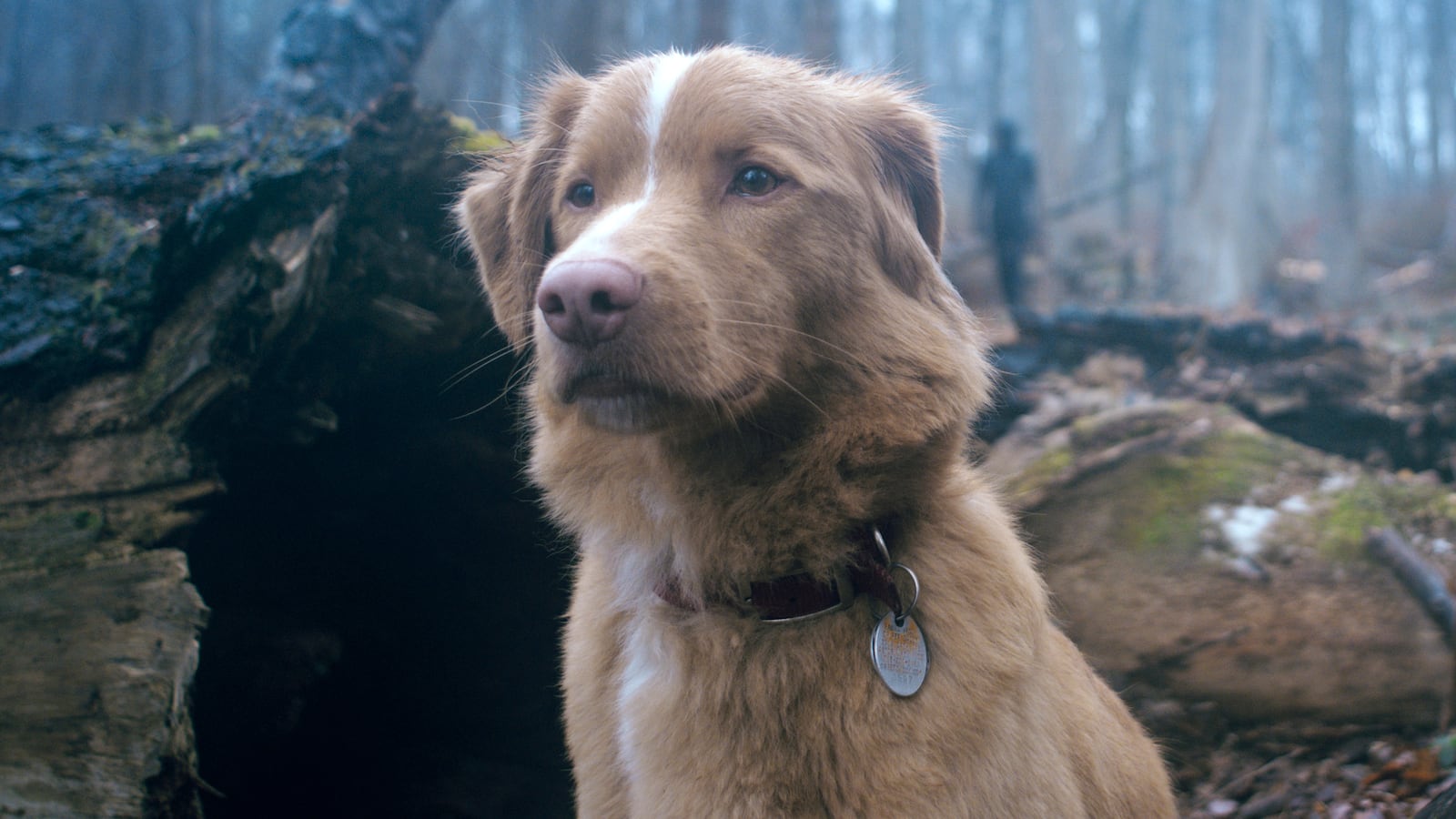In a manner similar to Steven Soderbergh’s Presence, Good Boy assumes a unique perspective on haunted-house mayhem—namely, that of a Nova Scotia Duck Tolling Retriever whose loyalty to his master is put to the test by swirling supernatural terrors.
Hewing, ahem, doggedly to its protagonist’s POV, Ben Leonberg’s debut feature, which hits theaters Oct. 3, is a compact and clever riff on its chosen genre that refuses to play it safe with its conceit, exploiting its canine character’s unique headspace for disorienting and anxious suspense. With an aesthetic ingenuity to match its pooch’s impressively expressive performance, it’s a thriller that ably justifies its central gimmick.
In a gloomy apartment, four-legged Indy is awakened by a buzzing cell phone call from Vera (Arielle Friedman), the sister of his owner Todd (Shane Jensen), who can’t answer because he’s slumped over in a chair, bleeding. Fortunately, Vera arrives in time to save Todd, although in the aftermath of this calamitous incident—which Indy, naturally, doesn’t wholly fathom—both man and dog ditch their New York City environs for the rural home of Todd’s grandfather (Larry Fessenden).
As indicated by her angry voice on the other end of the iPhone line, Vera is not pleased with this turn of events, both because she feels responsible for looking out for her brother, and because her grandfather’s abode—which sits behind a locked gate and is in disrepair—is reportedly “cursed” and “haunted.” Her reservations, it’s quickly revealed, are warranted, since the power is on the fritz and the house’s silence is regularly shattered by strange creaking noises that pique Indy’s curiosity.

Good Boy’s human drama occurs on the periphery of Indy’s experience, and his lack of comprehension about what’s taking place is juxtaposed with his sensory perceptiveness about the things his master cannot see.
Whether he’s roaming through a living room whose furniture is covered in white sheets, or sniffing in a toppled tree trunk where eyes glow malevolently in the dark, Indy moves through the world according to his own instincts. Much of his attention is directed toward the unilluminated nooks and crannies of Todd’s grandfather’s residence, where he appears to discern some concerning figure or energy.
What Indy spies is, initially, impossible to tell; Leonberg generates tension from Indy’s distinctive view of reality, in which people appear and disappear without warning or apparent reason, and act in ways that are beyond understanding—as when Todd stumbles into his bedroom like a heaving specter and collapses on his bed due to exhaustion from a procedure that’s left him with a bloody bandage on his forearm.
Indy doesn’t get what’s going on with Todd and, thus, neither do we, and Good Boy plays with that dynamic at the same time that it begins intimating that otherworldly trouble is afoot. At the family’s woodlands cemetery, Indy is confronted by a startling stranger in a head-to-toe camouflage outfit that makes him faintly resemble the Zodiac killer, and yet the man turns out to be simply a neighboring hunter who provides Todd with a generator to keep his flickering lights on.

Outside, he spots a shadowy form that vanishes as soon as it materializes. And beneath a dresser, he finds a red bandana that, once grasped, instigates a hallucination involving blood and an inky hand that’s as puzzling as his dreams, which further imply that all is not right with this locale.
In Good Boy, the ordinary and the extraordinary are difficult to differentiate, and that situation grows more pronounced as Todd’s condition deteriorates. Leonberg and Alex Cannon’s script drops breadcrumbs about its scenario through human conversations occurring in the dog’s general vicinity, all as it hints at a legitimately evil presence stalking Todd and Indy.

Awakened in the middle of the night, Indy descends to the first floor where a man darts past him and begins banging his head, bloodily, against the door to the basement. Once the individual speaks, it becomes clear that it’s Todd. However, the nature of his bizarre behavior—is he possessed? Or is Indy not grasping what’s actually taking place?—remains mysterious. Constantly shooting its human characters in silhouette or out of focus, the film blurs the line between the living and the dead, the real and the unreal.
Everything is fragmentary, illusory, and elusive in Good Boy, with Indy chasing after the ghost of Todd’s grandfather’s dog Bandit (who was never found following the man’s death), getting temporarily caught in one of the hunter’s fox traps, and watching Todd as he undergoes an MRI—the last of which indicates, as does a subsequent angry meeting with a doctor about experimental drug trials, that Todd is dying of an incurable malady. Once that’s established, Indy’s visions take on a more lucid meaning.
Leonberg, though, doesn’t totally spell things out; to the end, he sticks closely to Indy, whose plaintive whimpering and soulful eyes convey the dog’s mounting worry about the circumstances at hand and, in particular, the well-being of his beloved owner.
At only 73 minutes, Good Boy is a tad slight, and it’s hampered by a few too many sequences of Indy investigating puzzling noises that go nowhere. Still, cinematographer Wade Grebnoel’s use of shadow and light is striking, and the film’s adherence to its formula is impressive, imparting an entrancing impression of Indy’s limited (if also enhanced) perspective.

Suggesting that canines are attuned to planes of existence that are inaccessible to their two-legged companions, Leonberg’s tale ultimately blurs the line between them, its conclusion a hazy head-trip of sights and sounds that are at once difficult to parse and intimately connected. Building upon the bewildering action that preceded it, the finale descends into bleak, morose depths, even as it celebrates Indy for his deep compassion and heroic faithfulness.
Good Boy isn’t the first (horror) film told from a pooch’s vantage point, yet it captures the uniqueness of that animalistic POV like few before it. Its actual scares may be limited, but its form is impressively creative, just as its portrait of Indy and Todd’s bond is a poignant reminder that dogs truly are man’s best friend.






